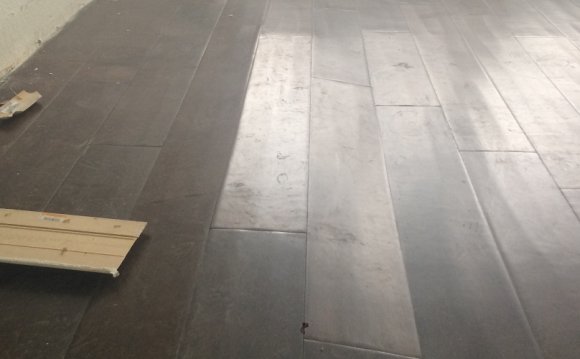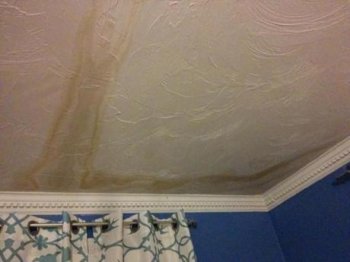
 Dear Merriam-Webster:
Dear Merriam-Webster:
Let the spelling fit the sentiment.
“Damage” is “DAMNage.”
Signed,
The Concord Carpenter
In this home, water that slipped under an ice dam caused the plaster to bubble.
Winter blankets us in misery every year, but 2015 brought with it the perfect storm for ice dams and inflicted the severest punishment those dams can dish out.
We’ve had 108.6 inches of snow fall on our roofs. (To put this into perspective, Logan Airport budgets for about 48 inches a year, according to the Massachusetts Port Authority.) To add insult to injury, we also endured bitterly cold temperatures.
Birth of an ice dam
By now I’m sure you know that ice dams occur in regions with deep snow and frigid temperatures. Compounding this problem are complex roof structures that trap snow, as well as inadequate insulation, ventilation, and air-leak sealing.
As snow increases in depth on a roof, it becomes an effective insulator — think igloo! Heat escaping from the house warms the underside of the roof and melts the bottom layer of snow, which drains down the roof, slips under the insulating snow cover, and freezes once it hits a colder surface like an overhang. The melting snow above feeds the icy layer, which grows thicker and thicker, creating an ice dam.
Get The Weekender in your inbox:
The Globe's top picks for what to see and do each weekend, in Boston and beyond.
And before long, the water builds up and creeps under the asphalt shingles, springing a leak inside the house.
Leaks and damage
Building-science experts advocate that we need to employ a whole-body approach to our homes, to look at them more as complete systems than at just the symptoms. Using this house-as-a-system approach, we can not only repair the damage, but potentially prevent it.
In this article I want to focus on repairs.
Insurance claims
Some folks do not realize they have policies that allow them to make a claim for water damage caused by rain, snow, or ice or accidental leaking or discharge from plumbing, heating, air conditioning, or a refrigeration system. The question to ask is does it make sense to make the claim or just foot the bill yourself? To make a claim, you need to contact your insurance provider and speak with an adjuster. Be prepared to provide:
■ Photos of the damage. If you are claiming damage to contents and have that coverage, provide photo evidence of that, too. The description should include the make/model, size, material, and replacement cost.
■ A written estimate, from a contractor, for the repairs needed. Estimates should include a description of the work and a breakdown of the costs by materials and labor. The replacement materials should be those of the same kind and quality of those being repaired.
■ Be sure to check your homeowner’s insurance to see if it will cover mold. If you find evidence of mold, your insurer will want to be contacted immediately and most likely will assign an adjuster to inspect the site. Be careful, a mold claim might affect your ability to get insurance later.
OK, so you have a leak. First step: Stop it! Next step: Dry! I recommend running fans ASAP. (If you have mold, however, fans will just spread the spores.) This may mean calling in professionals with special fans and carpet-cleaning machines.
Wet hardwood floors
Once you’ve stopped the leak, use fans to dry out walls, ceilings, and floors. Wallboard and plaster will dry quickly, but hardwood floors may take longer.
Solid hardwood floors react to water in three ways — they cup, crown, or buckle:
■ Crown: The boards raise up in the middle.
■ Cup: They raise up along the edges.
■ Buckle: They come apart and need to be replaced.
All is not lost when a hardwood floor gets wet; oftentimes it is not evident if the floor is damaged or just ticked off!
I once overflowed my kitchen sink and flooded the hardwood floor. After vacuuming up the water, I ran fans in the kitchen to dry the floor and in the basement to get the moisture out of the subfloor. I was lucky; there was no visible or long-term damage.
If there is no staining and the floor settles down, you’re good to go. If not, you’ll need to sand and refinish or replace the flooring.
What will this cost you? Here are some guidelines, assuming you hire an experienced, quality, and licensed contractor who uses good materials:
■ Sanding and refinishing: Plan on spending $2 to $3.50 a square foot. The higher range is assuming that the area needs to be stained to match an existing floor color.
■ Replacing and finishing: Figures vary by manufacturer and wood type, but here’s one example. Plan on spending up to $10 a square foot for 2¼-inch red oak flooring.
■ Removing and disposing of the old floor: This all depends on the contractor, but a good rule of thumb is to budget $3 a square foot.
Wet walls
How do you dry insulation inside a wall/ceiling cavity or the backside of the wallboard?
The BEST solution with wet insulation is to replace it. Wallboard can be dried in place if there is no obvious swelling, the seams are intact, and you can get adequate airflow to the wet surfaces. If not, remove and discard the insulation. Wall cavities should then be ventilated and dried.
I’d be lying if I said I never violated this principle. Several years back, I had two simultaneous ice dam leaks in my house — prior to installing a new roof with an ice and water shield. Luckily, I was able to stop the leaks within an hour of noticing them.
I did not open up the wall because I have extensive wainscoting and crown molding. That does not mean mold did not grow in that wall cavity. I’m sure it did.
(Need to make a hole? See my article on how to fix one on the preceding page.)
Mold concerns
A lot of people ask me how long it takes mold to grow after a recent water incident. First, let me just say I’ve never worked on a house that didn’t have mold somewhere. Mold is a microorganism that’s found everywhere. It can grow on almost anything as long as there is enough moisture. Inside your home, mold grows quickly on damp surfaces like bathroom walls and trim around windows. Mold may look like furry growth, black stains, or specks of black, white, orange, green, or brown.









